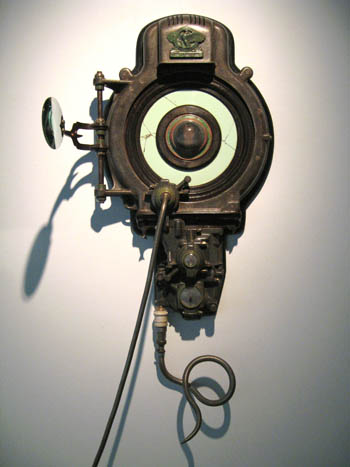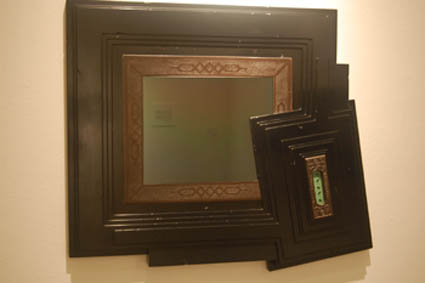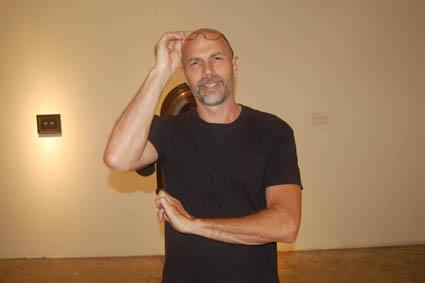Steve Brudniak, the artist as mad scientist, or maybe vice versa, has invented a new “emanating reflection optical lens,” a dark, reflective glass that appears to project hologram-like images when you look at it just right. Incorporated into his new series “Noumenon,” named for the “ultimate source of all things,” the dark glass components provide a glimpse into an abyss of endless darkness pierced by startling visions.
Resembling artifacts recovered from Captain Nemo’s Nautilus or maybe scavenged from Nikola Tesla’s laboratory, the Austin artist’s found-object sculptures are on view in “Noumenon and Other New Work” through July 31 at the Blue Star Contemporary Art Center. Brudniak is set to give a gallery talk at 6:30 p.m. Wednesday, July 28.
The faint Victorian cast of Brudniak’s well-crafted pieces that resemble obsolete or even occultish 19th-century scientific instruments has been described as “steampunk,” but his work has a conceptual and now a more autobiographical underpinning that is more intuitive than technical. He collects all sorts of odd-looking mechanical objects in his studio, which he sometimes spends years fitting together.
“I have always worked in a parallel with the surrealist modus operandi, dipping into the subconscious for inspiration, trying to get a glimpse of the other side,” Brudniak writes in his label notes. “The wicked witch has her crystal ball, Nostradamus had a pool of dark water, the Azetecs their scrying mirrors of shiny black onyx.”
Parts of a cast iron stove and an old fireplace have been placed within a dark, heavy, somber ipe wood frame to form “Noumenon,” an altar-like assemblage resembling an old tabletop jukebox with a dark glass window that appears to shoot out countless red dots of light when viewed from the proper angle – no glasses required. Brudniak says the effect is especially pronounced when he uses a laser pointer to create a beautiful spider web of geometry that twists and contorts with each movement of the beam.
Weird brass tentacles dangle from most of the pieces in the “Noumenon” series, intended as Ganesha-inspired elephant trunk-like symbols of the searching ego, or what Brudniak calls “the reaching out egoic manifestation brought on by thinking.” “Noumenon: Objectifying in Four Parts” looks like a row of four brass mail slots with tentacle snouts, while “Noumenon and Awareness of the Endless Succession of Thought” has windows pregnant with little baby tentacles, unborn thoughts.
“The Vagus Leviathan,” is the most personal piece, centered on the portrait of an old girl friend that appears and then blurs out like Auntie Em when Dorothy looked into the witch’s crystal ball in “The Wizard of Oz.” The way she moves in and out of sight reflects the ups and downs of a relationship as well as the fading and then sudden sharp recall of memory. Parts of the piece include a 1940s cinema projector, a water main cover and a Volkswagen engine block. Tentacles dangle and there are gauges that rather than the physical are set to measure the emotional.
Brudniak used the other half of the ball of fiber optic material he cut in two for the crystal ball effect in a piece inspired by his recurring dreams of moving along the banks of various waterways. Photographs he took while canoeing on Lake Austin are lit from behind and seen through the distorting curved fiber optic lenses in “Canal Dreams.”
Organic material is a recurring element in some of his work. Brudniak has used blood in the past, but he settled for hair as part of small sculptures that rode into space on the Russian Soyuz TMA-13 rocket with Austin video game wiz Richard Garriott, who also carried a lock from his father, former shuttle astronaut Owen Garriott. In “Astrogeneris Mementos,” Bruniak secured the locks of hair into memento chambers inspired by 18th and 19th-century memento mori lockets.
Salt crystals containing 250 million-year-old bacteria, which came to life after being released from its dormant suspension, are displayed in a grid in “The Menagerie of Eternal Life.” Brudniak acquired the tiny chips from Dr. Russell Vreeland and Dr. William Rosenzweig of West Chester University in Pennsylvania, who discovered the crystal in a New Mexico salt mine.
Prosopocoilus bruijni, a stag beetle from the island of Sulawesi in Indonesia, can be detected, barely, through the dark glass of “Scrying the Present in the Shadow of a Doubt,” which also has a side frame of off-kilter gauges.
Most mysterious is “The Dark Glass,” made from a mail drop in Austin’s Alamo Hotel built in 1929 with the slot now a window of dark glass, which reveals multiples of reflected images and shifts in the color spectrum when looked at just right.











